Last Updated on June 26, 2018 by Heather Hart, ACSM EP, CSCS
A common question I hear from newer runners, or at least new-to-trail runners, is whether or not they can use their road shoe on the trails, or “do I really need trail running shoes?”. Runners seem to come from two different mindsets: the “sweet, an excuse to buy new gear” camp, or the “ugggh why is this ‘inexpensive sport’ costing me SO MUCH MONEY?” team. In this post, we’re going to break down the differences between trail running and road running shoes, and determine whether or not you really need to spring for a second pair of shoes just for the trail.
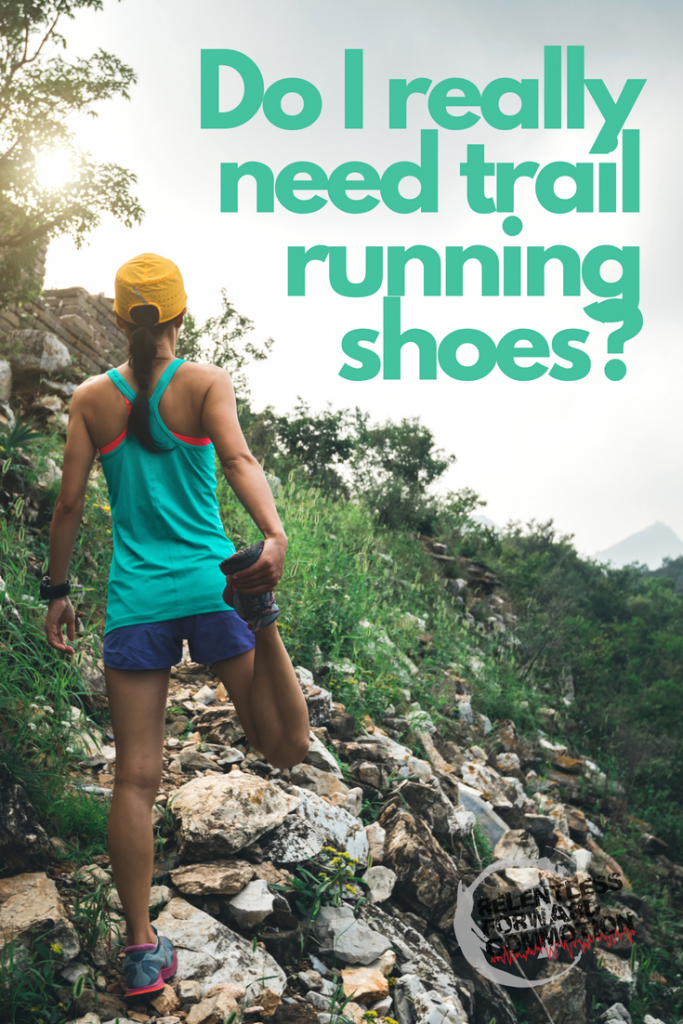
Here in Myrtle Beach, with our mostly sandy and relatively non technical trails, having trail shoes is not always a deal breaker. While some of the “steeper” (definitely a relative term) climbs might feel a bit slippery in road shoes, you can absolutely get away with running trails in your normal road shoes…as long as you don’t mind getting them a little dirty. This isn’t always the case, however, as some trails in other locations are significantly more technical, with roots, scree, rock faces, and more. Needless to say, the features of a trail shoe can certainly make your trail running experience significantly more enjoyable.

Flat. Sandy. Not very technical. Myrtle Beach trail running at it’s finest!
Differences Between Road and Trail Running Shoes:
First, let’s look at the differences between road running and trail running specific shoes.
Aggressive Tread/ Outsole.
The outsole (or bottom) of a road shoe is designed to be lightweight, fast, and responsive. A trail shoe, however, is typically made of a sturdier rubber compared to that of a road running shoe, and features aggressive tread to help you tackle steep climbs or slippery terrain.
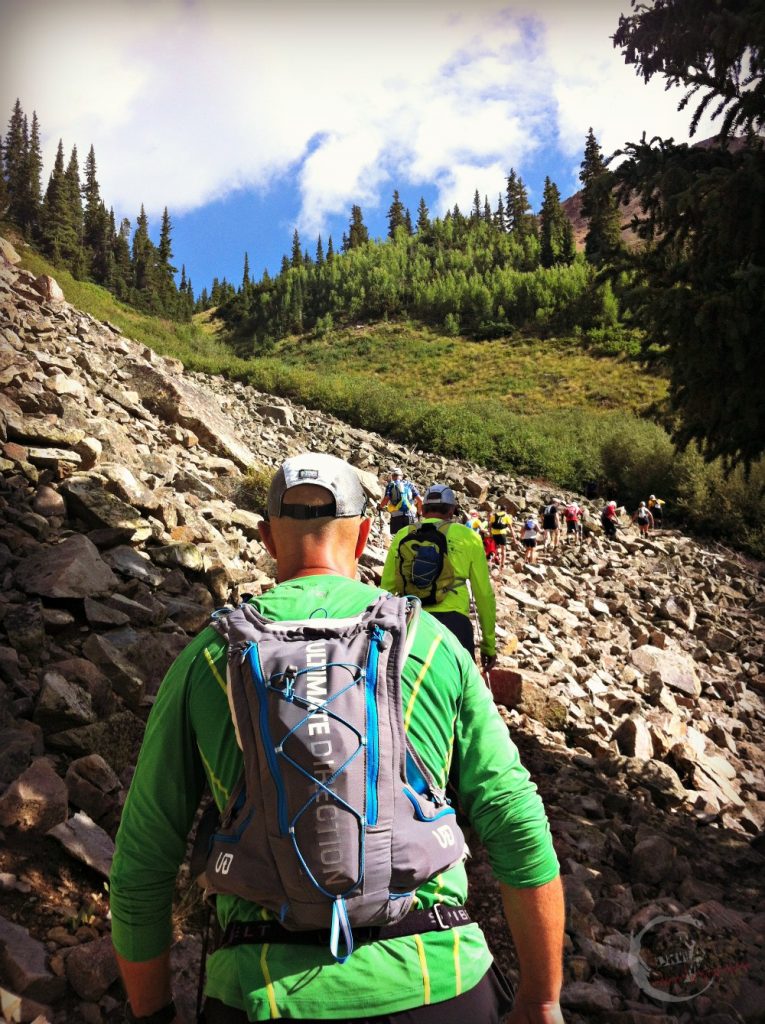
The depth of the tread varies on the type of trail shoe; some are smaller and designed for all terrain use (switching from road to off road), while others have bigger, burlier treads and grooves for more rough terrain. The sturdier rubber helps protect your feet from sharp rocks and roots, and also allows the shoe to withstand the harsh terrain without breaking down as quickly. The trade off for this protection is typically a slightly heavier shoe, compared to road models.
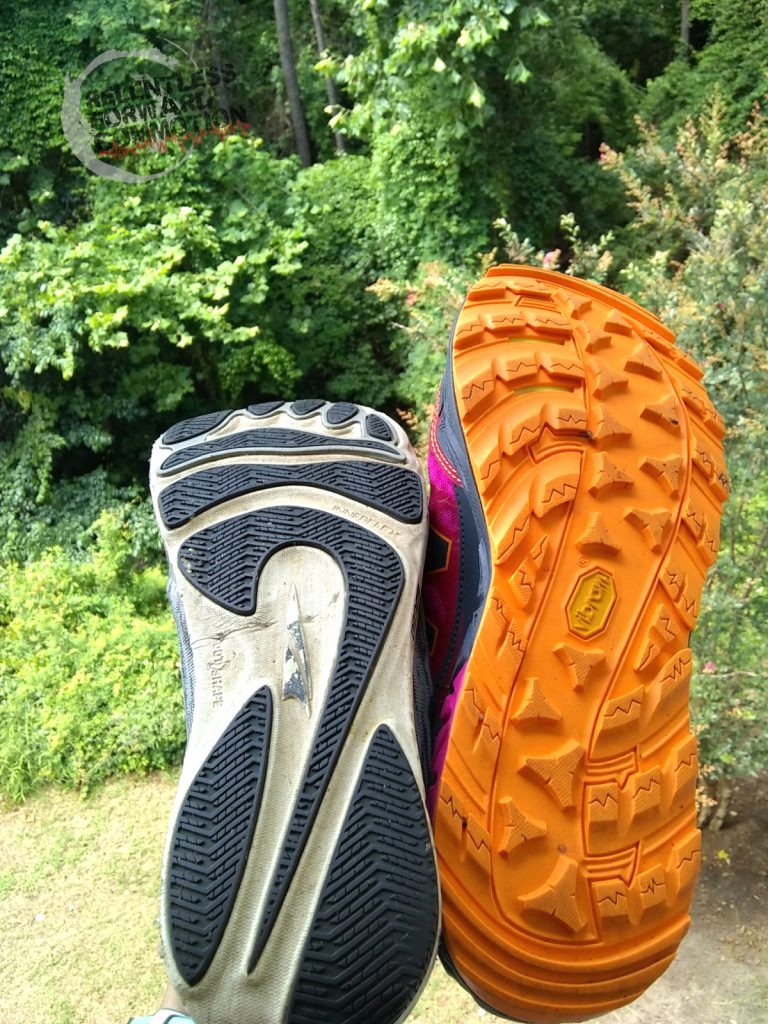
Pictured on the left is a (well loved) Altra Escalante, a lightweight road shoe. On the right is the New Balance Leadville, a more aggressive trail shoe. Notice the difference in the outsole.
Supportive, Durable Upper.
Many road shoes are designed with the goal of keeping the weight of the shoe down. Lightweight mesh uppers with sublimated or printed patterns help provide structure without adding too much weight. In a trail shoe, however, these types of uppers are more vulnerable to tears from rocks, roots, brush, multiple stream crossings, etc. Therefore, a trail shoe is typically going to feature a sturdier upper, with more durable materials and reinforced construction. Further, the upper helps to provide even more structure and support for the constant lateral movements that occur on trail, helping to guide your feet and ankles with the constant, unpredictable movements.
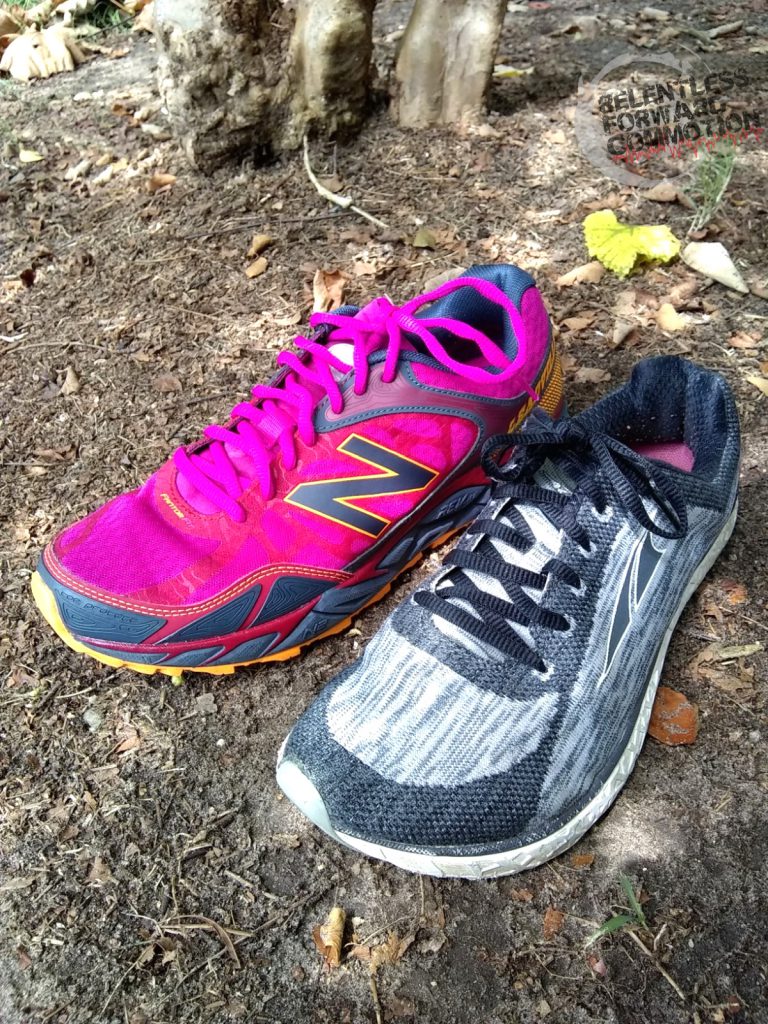
The Leadville (left, pink) has a much more structured upper, with various overlays of sturdier fabric to help protect and support the foot while on trails. The Escalante (right) is essentially one soft piece of fabric, to help keep the weight of the shoe down, and offers very little support and protection.
Wider Last.
Trail shoes are typically built on a wider last, the mold that the shoe is formed around during construction. A wider last and wider outsole will provide a bit more of a stable base for the lateral movements that often occur on trail, while hopping around rocks, roots, and other obstacles. This is not to be confused with “stability shoes”, which are typically designed with an internal stability post that helps slow down the rate of over-pronation.
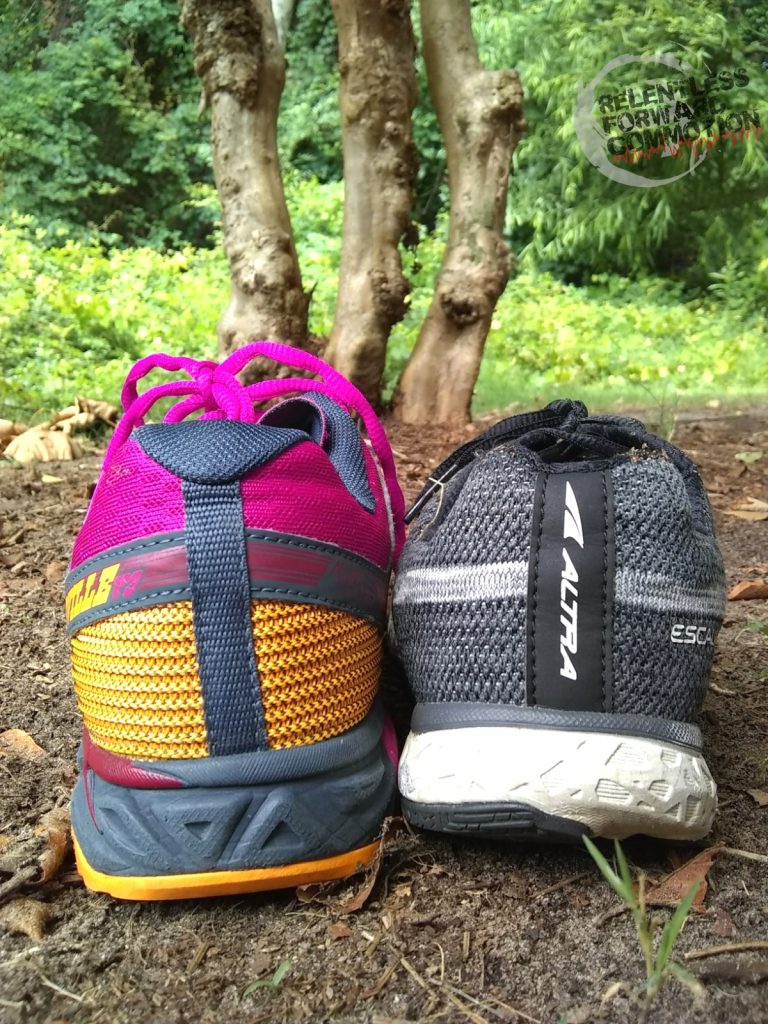
These are both a women’s size 10.5. Notice how much more “shoe” there is to the trail version (left) vs. road (right).
Additional Features.
Many trail shoes have additional features, such as a reinforced toe (for accidental rock kicking), gaiter traps and hooks (to hold hold your gaiters in place and prevent debris from entering your shoes), an internal rock plate to help protect the forefoot from sharp rocks underfoot, and sometimes even waterproof materials to help keep your feet dry and comfortable.
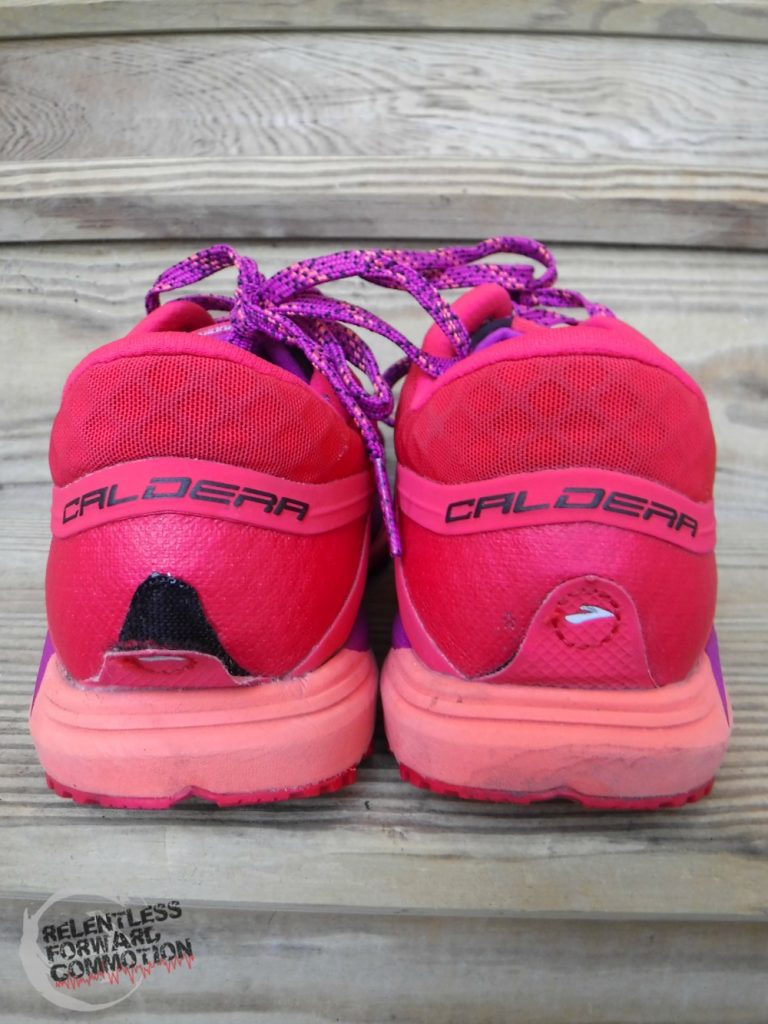
Gaiter “traps” on the back of the Brooks Caldera
Do I Really Need Trail Running Shoes?
Next, let’s determine if you actually need a pair of trail running shoes. Some questions to ask yourself:
Frequency
How often will you be running on trails? If it’s a one-shot deal, then perhaps springing to buy another pair of shoes isn’t really worth the investment. If you will be hitting the trails on a regular basis, then buying a pair of shoes specifically for the trail is a good idea. Not only will you be more comfortable on the terrain, but you will preserve the integrity (i.e. not thoroughly trash) of your road shoes.
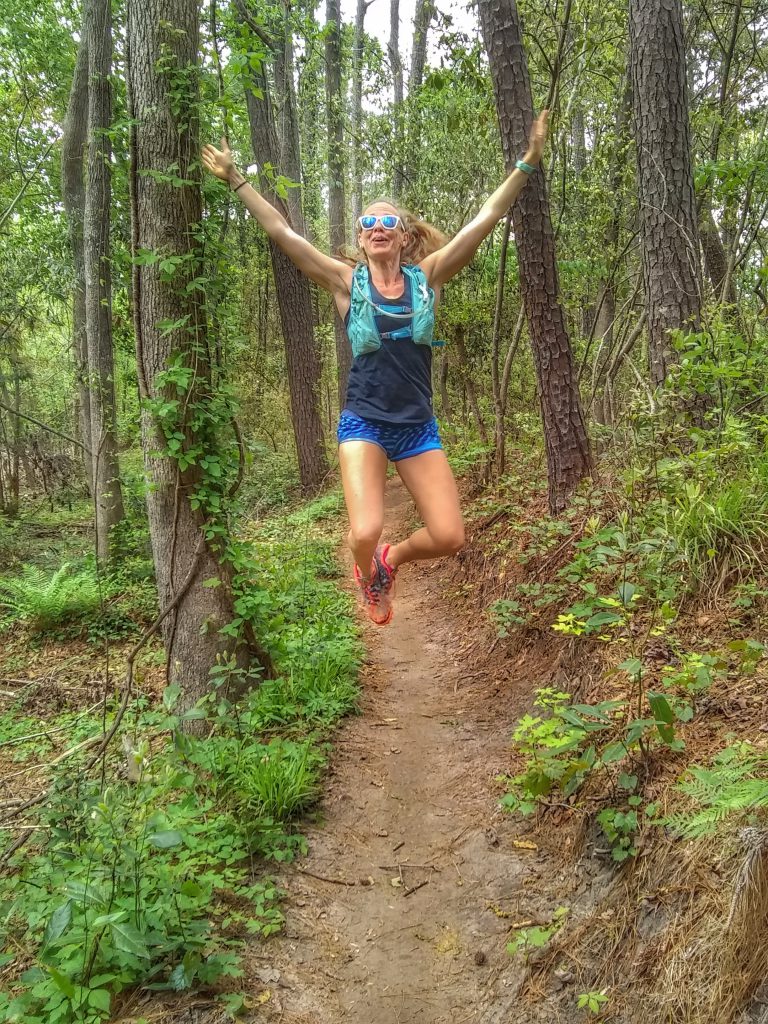
Actual cheesy photo of what frequent trail running will do to you. (Happiness. It will make you happy.)
Trail Type/Conditions
What sort of trail will you be running on? If it’s a wildly technical trail, you’ll really wish you were running in a pair of trail running shoes, even if you only head to the trail sporadically. Not sure what you will face? Ask local runners who do frequent the trail what they recommend. If they do suggest trail shoes, they will also be able to give suggestions on what type of trail shoe you may need (super aggressive, all terrain, etc.)

Support
Do you have weak ankles? Prone to twisting them on curbs, rocks, and roots? Do you stub your toes often? It’s OK if you answered “yes”, you aren’t alone. The good news is that over time, trail running will help build strength in your ankles and lower body, as well as increase proprioception (aka, the ability to pick up your feet and not trip over everything – trust me, I’m reformed frequent trail faller). If this is you, I would suggest a trail shoe regardless of terrain, as it will provide the extra support to help protect your feet and lower legs as you gain agility and trail skills.
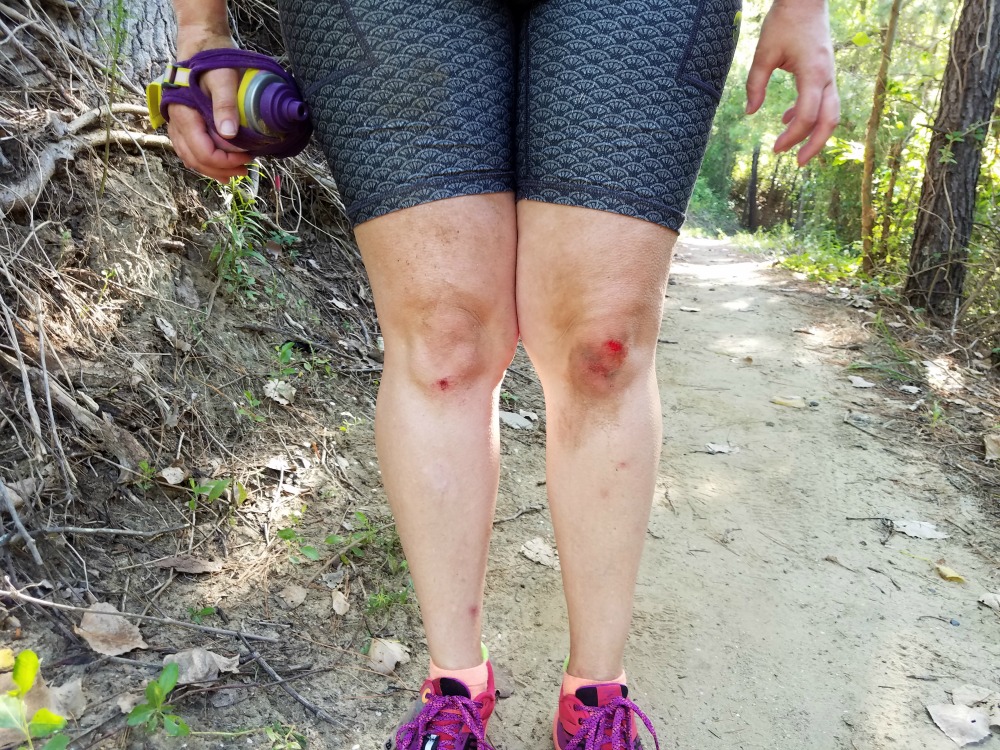
My friend Kristy, modeling a fresh set of “trail kissed” knees…
_____________________________________________
So, do you actually NEED trail running shoes? No. Yes. Maybe.
In short, you can certainly use your road shoes on the trail. You can also use your trail shoes on the road (though it will beat up the tread pretty quickly, and they might feel a little clunky.) However, if you decide to add trail running to your regular training routine, investing in a pair of trail specific shoes will make your trail running experience more enjoyable, and will help preserve your road running shoes for your road or treadmill miles.
Happy Trails!
Heather Hart is an ACSM certified Exercise Physiologist, NSCA Certified Strength and Conditioning Specialist (CSCS), UESCA certified Ultrarunning Coach, RRCA certified Running Coach, co-founder of Hart Strength and Endurance Coaching, and creator of this site, Relentless Forward Commotion. She is a mom of two teen boys, and has been running and racing distances of 5K to 100+ miles for over a decade. Heather has been writing and encouraging others to find a love for fitness and movement since 2009.
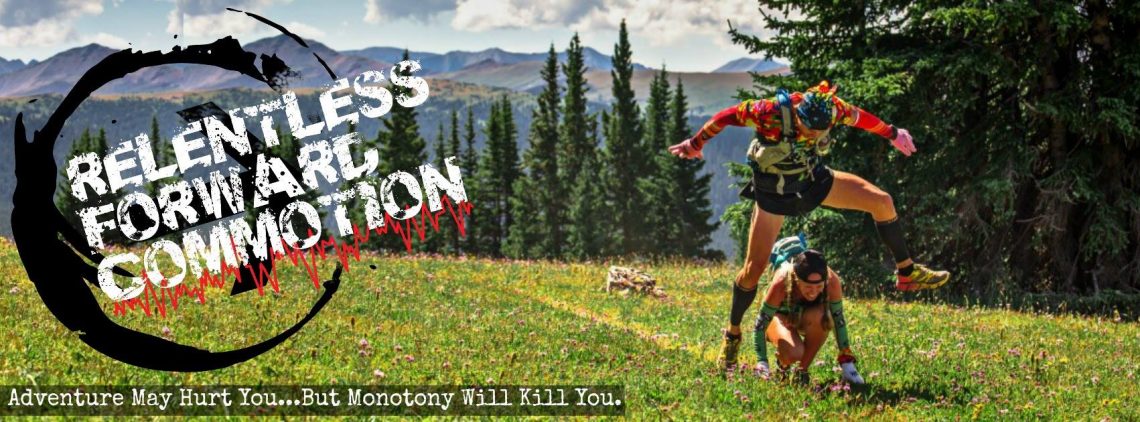
Cory McNair
Great advice. I would add that it depends on your road shoe, too. I wouldn’t take the aforementioned Escalante on even a moderately rippled fire road, but the ample rubber and deep flex grooves on a Saucony Triumph or a Brooks Ghost can give you plenty of off-road grip as long as things don’t get too technical.
Heather
Yep, and it depends on the person! I WOULD take the escalante on a fire road, but I also run in sandals sometimes, so my feet are used to minimal cushion/feeling things underfoot.
Jan
Nice article.
Here in The Netherlands (EU) I find them, _personally_, not really needed. We have either sandy (very sandy, sometimes) trails or you’ll find clay in your path. With wet clay on your soles it really doesnt matter, you’re going to slip 🙂 Happy times!
There are some rocky trails, and then yes, you could use them. They do help protecting your toes/feet from treeroots…
But most of the time you will also encounter (a bit of, some) roads or ‘flat’ woodroads. Í’d rather have normal shoes on my feet at that point than trailshoes. The above mentoined Brooks Ghosts are my favorite then. Nice shoe (fitwise), good thread on the soles for grip.
If, however, you go to the Ardennen (Belgium, you should look it up) where you’ll encounter waaaay more rocks, streams, and up-and-downhill paths, a decent pair of trailshoes can come real handy.
So yes, YMMV (it does btw, you run way more than me :-)) as will your underground.
But for starting trailers I’d not reccomend trailshoes. Just show up and run, have a good time, wow yourself at the aid/foodstations, and see if it’s for you.
But there’s nothing wrong in running trails on your road shoes. As long as you run happy 🙂
Cheers,
Jan
Annmarie (@FitFoodieMama)
This was a great read! I have been wanting a new pair of trail running shoes as the ones I have don’t have a really sturdy upper – no bueno with all the rocks, twigs and such on the trails here!
Virjinia
I don’t run enough in technical trails to need trails shoes but I totally agree with all this! Maybe one days when I get serious about trail running, I’ll splurge on a pair. For now, I’ll run my sandy “trails” in my road shoes and get a little dirty!
Organic Runner Mom
Trail shoes are a must here in NH. The tread is key as we have lots of super technical trails to run on.Great post!
Kat Stewart
great informative article ya got here 🙂 thanks for the info!